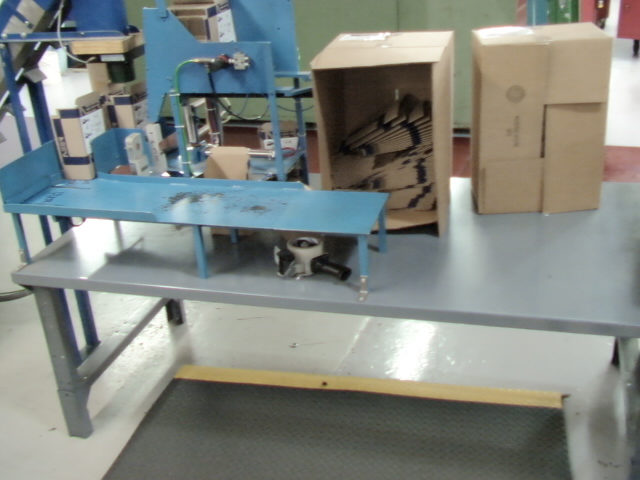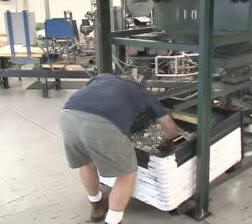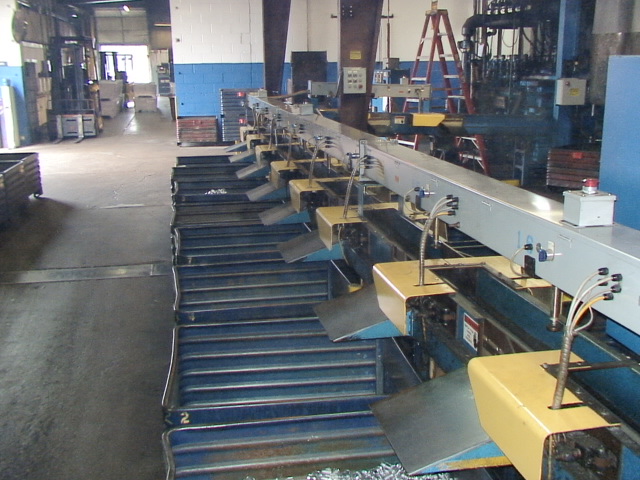Ergonomics, Efficiency, and Cost Savings
Small Manufacturing Example
July 25, 2006
Introduction
This case example is
important for several reasons:
-
It is
comprehensive — plant-wide over a 10-year period.
-
The
ergonomics improvements were far more thorough than most plants.
-
The
operation was small in unglamorous basic industry (100 employees in
die casting)
and
there were no professional engineers on staff. The changes were
primarily implemented by the maintenance staff. It shows that it is
not necessary to be large or especially sophisticated to achieve
significant benefits.
Summary
Costs and Benefits

Over a 10-year period, this plant
invested about one-half million dollars in making operations more
human-compatible. At the time of this analysis, the annual
benefits were about two million dollars.
Breakdown
of Benefits
These graphs were
generated from from plant records, showing the changes over the
10-year period.
Productivity was up about 50% and workers compensation costs,
absenteeism, and turnover were down 70–90 %. Converting these
changes to dollars yielded the two million dollar annual savings.
More details
The plant produces electrical fittings and has a
large die cast operation. Total pounds of zinc cast per employee in
this case is a good measure of productivity. The actual numbers are:
1995 10,100
lbs 200 employees
2006 7,800 lbs 100 employees
The absenteeism and turnover reductions
were
related in part to other factors, primarily the economic downturn at
the time of this analysis. However, the work area with the
highest absenteeism and turnover was in the hot die cast building and
involved repetitive lifting of heavy loads. These rather
undesirable jobs were among the first to be addressed and the
reduction in absenteeism and turnover can be directly related to these
improvements.
Breakdown of Costs and Benefits
More details on the specific improvements are
provided below, but the summary costs and benefits can
be summarized roughly as follows:
Investment Costs
|
Hopper Loading Systems (2) |
$120,000 |
|
Packing Stations (17) |
42,500 |
|
Tumbling Material Handling System |
330,000 |
|
Total One-Time Costs |
$492,500 |
Annual Savings
|
Labor |
$1,200,000 |
|
Workers’ Comp |
410,000 |
|
Absenteeism |
300,000 |
|
Turnover |
not available |
|
Total Annual Benefits |
$1,910,000 + |
Examples of Improvements
The equipment changes were a combination of
ergonomics, lean manufacturing, and automation. At this level, these
strategies are often intertwined. The following are brief
descriptions of the most important improvements.
Packing
I n the past, packing was done in a different area
and the assembled products were brought to that area in bins with a
forklift. As part of a lean manufacturing strategy, the plant decided
to relocate the packing into the assembly area. To achieve this goal,
the plant needed to do two things:
-
Reduce the physical and time demands on the
assembly employees by eliminating the manual loading of bins, which
was accomplished by using the loading system described above.
-
Raise the completed parts up to an appropriate
work height.
Of special note, plant engineering decided that
purchasing inclined conveyors was too expensive, so they built their
own for roughly $400 using an I-beam, an electric motor, a belt, and a
modest amount of steel supports.
 |
 |
|
Inclined conveyor:
homemade, inexpensive to bring products up
to working height. |
Packing station.
Features include automatic counting system, cylinders to push product
boxes into position, and a two-tiered packing station to reduce arm motions when
loading product boxes into shipping boxes. |
|
Ergonomics made the lean
concept feasible
The first attempt to combine packing with assembly
caused an “employee rebellion” and failed. The
problem was that the initial attempt required
employees to bend to floor level repetitively to
retrieve the finished products. By adding the
inclined conveyor and building a packing station
with a variety of ergonomic features, the leaner
system became successful. |
Hopper Loader
The most unique innovation at this site is an
automatic hopper loading system. The tasks it replaced were the
common ones of manually loading a hopper, as shown in the following
photos, with strain on the arm and back.
 |
 |
|
Before: Height extremes — ending to scoop parts
from low container, then reaching high to load
into hopper |
This hopper loading system was conceived and
built by plant personnel. In addition to saving wear and tear on
employees, it saved 5000 sq. ft. of floor space, which enabled
assembly cells to be placed in a room that was otherwise too small.
Moreover, eliminating the need to load hoppers enabled efficient
packing of the product in these cells.
|
 |
|
After: Parts from bins in a racking system
(A) drop as needed into a conveying system (B) to a loader.
The loader runs almost instantaneously along a monorail (C) to fill the
various chutes leading to machines (D). |
Tumbling Automation
The final major improvement was in the tumbling portion of the die
cast area.
 |
|
Before: Multiple lifts of materials throughout
production process. |
Previously, each load of cast parts had
to be lifted 12 times in the process of being tumbled. Sketches
of those lifts are shown above, obviously in a manner with a high risk
of injury as well as wasting time. This area especially was a
source of high workers’ compensation claims, absenteeism, and
turnover.
|
 |
|
After:
Automated sorting and handling system |
Many of these
high-injury tasks were automated. Part of
the system is shown in the photo above. This system was the most
expensive investment of those described here, and also yielded the
highest return in savings.
Other improvements
Variety of other standard ergonomics
improvements, including lift tables, turntables, anti-fatigue matting,
etc.
Synergy
“We tend now to look at ergonomics
as more a part of a systems approach to continuous improvement than
just a tool to improve safety. We didn’t start out that way, but
rather we morphed to that realization.
“The lean concepts of waste and
flow, the quality concept of continuous improvement, and the
ergonomics concept of wasted motion/poor motions as part of the same
drive for competitive advantage in cost and service excellence. These
tools and their applications are synergistic, not independent
strategies!”
—
Plant Manager
Comments
Standard accounting systems often don't lend themselves to taking into account longer term perspectives as well as cost
avoidance factors such as workers’ compensation costs. Consequently,
it can be helpful occasionally to take a step back and make additional
calculations such as those here.
Probably most plants that have
implemented similar improvements have achieved the same types of positive
results. The difference in this case is that the
plant is small and the effects of process improvements more
measurable. In large operations, there are often so many variables
that it can be difficult to sort out which changes are related to
which financial savings. Additionally, in this case, virtually all of
jobs in this facility have been affected, not just single work cells
or departments. So again, measurements are more meaningful than
usual.
The improvement process was decidedly low tech: (1) Identify
difficult jobs based on common knowledge or discussions with
employees, then (2) brainstorm creative solutions.
A few other positive aspects of this facility
are:
- Senior management is especially skilled in
good communications with the workforce and in promoting change.
- The maintenance team is unusually
creative.
- The unionized workforce is involved.
|
